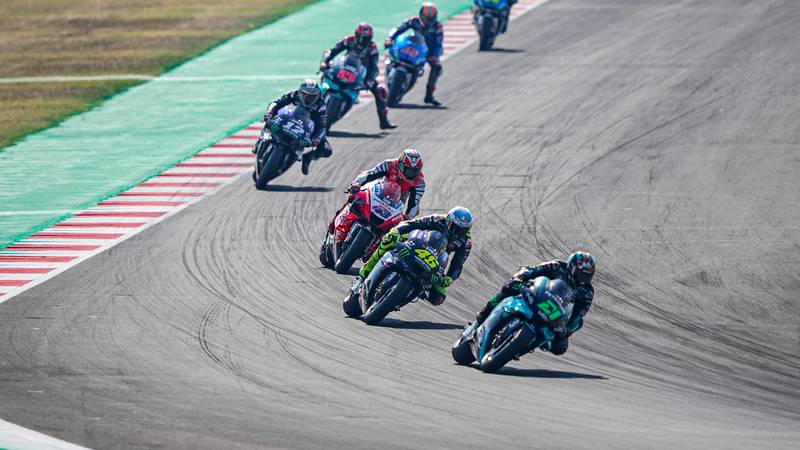The physics of rotational force make an inline-four more stable than a V4 over the bumps so that Yamaha and Suzuki riders can attack corners faster and do so without fighting their bikes so much and exhausting themselves over race distance.
Honda RC213V rider Cal Crutchlow immediately noticed the difference when he watched Saturday morning practice from trackside after he had been declared unfit to ride, due to post-surgery complications
“The Yamaha and Suzuki seem to go over the bumps more smoothly than the other bikes,” he said.
This blog has already explained why inline-four MotoGP bikes are friendlier through the corners than V4s, but here’s a quick recap, specifically related to the bumps at Misano.
The secret goes to the absolute heart of every MotoGP bike – its crankshaft, which has a significant effect of the behaviour of the motorcycle. MotoGP crankshafts weigh around nine or ten kilos and they rotate at around 18,000rpm, so that’s a huge amount of kinetic energy!
When a bike rides over bumps it can become unstable. However, the wider crankshaft of an inline-four engine has a higher moment of inertia, which makes it more resistant to external forces – like bumps or slides – that want to upset the bike.
On the other hand, a V4 engine’s shorter crankshaft has a lower moment of inertia, so that bumps and slides make the bike twitchier and more unstable.
Thus when a Yamaha or Suzuki encounters a series of bumps it rides over them much better than a V4, which gets twitchy at best, terrifying at worst.
“It’s pretty damn simple,” one V4 engineer told me recently. “We say that if the rider’s arse is open, his hand is closed!”
Rossi, who came within three-tenths of a second of scoring his 200th MotoGP podium on Sunday, really enjoyed the friendliness of his inline-four.
“This is a very tricky track – very narrow and very bumpy – but our bike is very stable, so we can enter corners fast, especially the fast corners,” he said, referring to Misano’s super-quick Turns 11 and 12, which can make a huge difference to lap times.
Michelin’s 2020 rear slick continues to help the inline-fours and hinder the V4s, thus shifting the balance of power in MotoGP, because the company’s older, harder-construction rear sick mostly favoured the V4s.

Inline-fours to the fore at Misano: four Yamahas, two Suzukis, one Ducati
Yamaha
“The new tyre is no problem at all for us – it’s just better everywhere,” smiled Petronas Yamaha team manager Wilco Zeelenberg at Misano. “It’s easier and it gives us the edge grip we need.
“We sometimes struggled with the old tyre and we also sometimes struggled with the Bridgestone rear when they brought their special tyres with heat-treated edges to some tracks. These tyres were harder on the edge, so they were a disaster for us, because we lost the edge grip we needed.”
The same goes for Suzuki.
“I’ve heard comments from some [V4] manufacturers, but the only difference for us with the new rear tyre is that we have a bit more grip and consistency,” said Suzuki technical manager Ken Kawauchi at Misano.
The situation is very different at Ducati, which despite everything leads the riders championship with Andrea Dovizioso.
“At the moment it’s very difficult for Andrea to ride the bike like he did in the last few years, when he slid the rear in the entry of the corner to turn the bike,” said factory Ducati team manager Davide Tardozzi. “The grip of the new tyre is incredible and more grip is always welcome, but sometimes it can create problems, so Andrea cannot slide the bike to make the turn. But everyone has the same tyres, so it is our job to find the solution.”
The tyre’s softer carcass seems to work better with inline-four bikes because their crankshaft dynamics allow them to use smoother cornering lines, so they load the tyre more consistently through the corners. On the other hand, the dynamics of a V4’s shorter crankshaft demands the V4 rider uses more acute lines, which load the tyre more aggressively in some parts of the corner, causing the tyre to deflect (squish) too much.
Pramac Ducati rider Jack Miller – currently third in the points chase behind Dovizioso and Quartararo – also has his difficulties with the tyre. At Misano he had issues, in practice and in the race, when he ignored his gut instinct and raced the soft rear instead of the medium, following advice from his technicians.
The Link LonkSeptember 14, 2020 at 05:08PM
https://ift.tt/2GYXido
How Yamaha and Suzuki made some history at Misano - Motor Sport
https://ift.tt/2ZqQevw
Yamaha

No comments:
Post a Comment